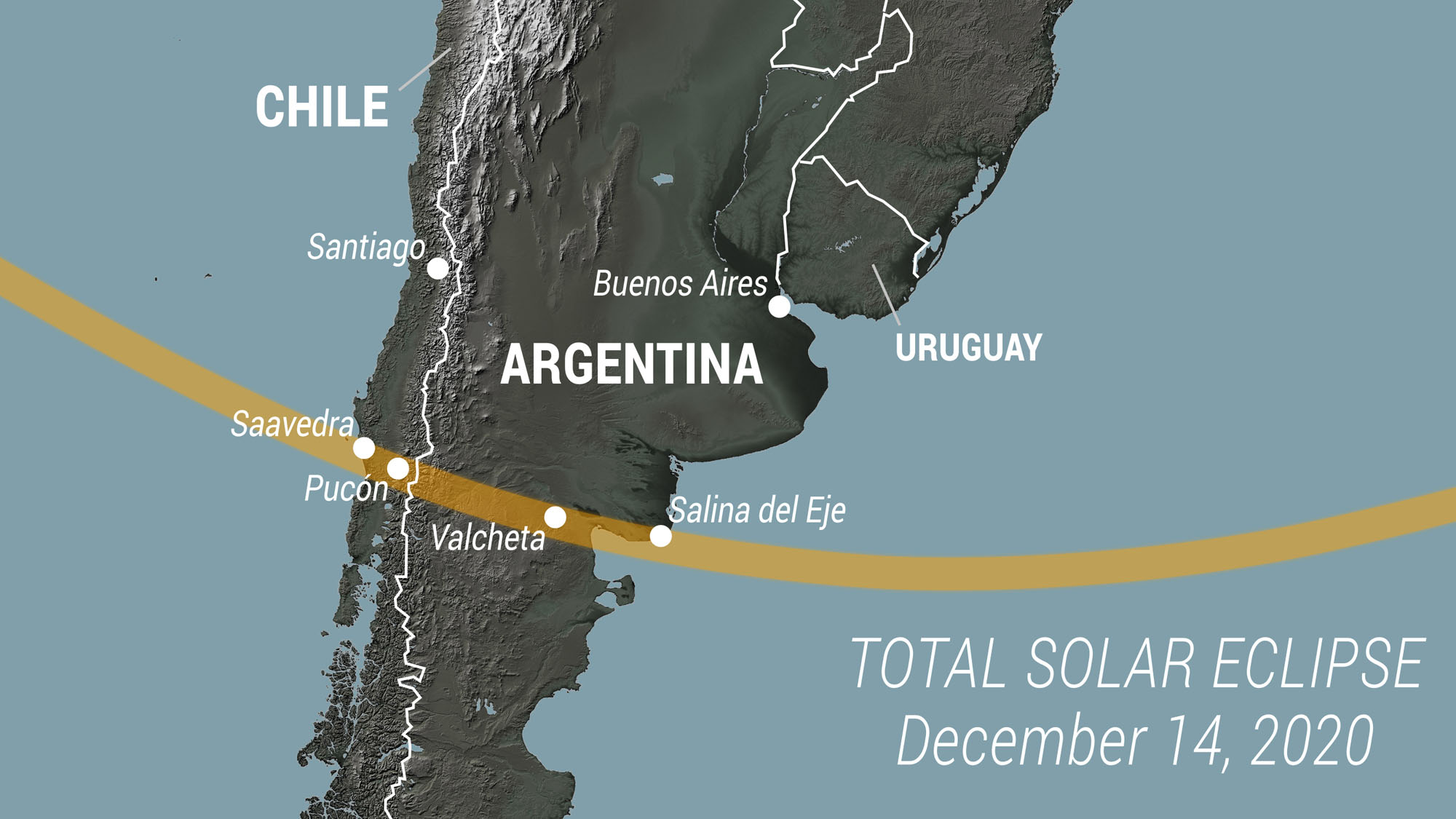It would only seem appropriate that the final eclipse in this eccentric year of 2020 will be visible only from Patagonia — nicknamed "the end of the world," because it reaches all the way to the bottom of the South American continent.
While parts of Chile and Argentina will experience a total solar eclipse, with the moon completely blocking out the sun, a partial solar eclipse will be visible only from the lower two-thirds of South America and a narrow slice of southwestern Africa. North America will not see any part of it.
The narrow path of the 2020 total solar eclipse starts over the South Atlantic Ocean at 9:33 a.m. EST (1433 GMT), about 2,400 miles (3,900 kilometers) southeast of the Hawaiian Islands, and 87 minutes later will reach the Pacific coast of Chile, at 11 a.m. EST (1600 GMT). It will take about 25 minutes to sweep southeast through the Patagonia section of Chile and Argentina, then continues out over the South Atlantic Ocean for about 4,350 miles (7,000 km), with no further landfall, before coming to an end at local sunset about 230 miles (370 km) southwest of the coast of Namibia at 12:54 p.m. EST (1754 GMT).
Video: Total Solar Eclipse in December 2020 - Where is it visible?
Related: Total solar eclipse 2020: Here's how to watch it online
| Location | Partial begins | Totality begins | Duration | Partial ends |
|---|---|---|---|---|
| Saavedra | 11:38 a.m. | 1:00 p.m. | 2m 4s | 2:28 p.m. |
| Pucon | 11:41 a.m. | 1:03 p.m. | 2m 9s | 2:31 p.m. |
| Valcheta | 11:52 a.m. | 1:16 p.m. | 2m 11s | 2:43 p.m. |
| Salina del Eje | 11:59 a.m. | 1:25 p.m. | 6s | 2:50 p.m. |
| Location | Partial begins | Maximum | Partial ends | Magnitude |
|---|---|---|---|---|
| Santiago | 11:36 a.m. | 1:01 p.m. | 2:31 p.m. | 0.83 |
| Buenos Aires | 12:03 p.m. | 1:32 p.m. | 2:59 p.m. | 0.79 |
| Montevideo | 12:09 p.m. | 1:37 p.m. | 3:03 p.m. | 0.79 |
| São Paulo | 12:45 p.m. | 2:04 p.m. | 3:16 p.m. | 0.43 |
| Lima, Peru | 9:16 a.m. | 10:16 a.m. | 11:23 a.m. | 0.28 |
| Walvis Bay, Namibia | 6:58 p.m. | 7:40 p.m. | after sunset | 0.76 |
The regions of Chile and Argentina traversed by the total eclipse are, unfortunately, rather sparsely populated. Fortunately, during its 4-minute passage over Chile, the moon's dark shadow will pass over the cities of Villaricca (pop. 46,000) and Pucon (pop. 22,000), two popular tourist resort areas that are quite popular during the summertime which officially begins only a week later. Both cities have favorable climatological prospects, suggesting that the weather might be fair and dry for eclipse viewing.
The point of greatest eclipse is 18 miles (29 km) northwest of Sierra Colorada, a village and municipality in Río Negro Province in Argentina (pop. 1,300). Here the path width is 55 miles (90 km) and the total eclipse will last 2 minutes 9.6 seconds.
Approximately 400 to 500 miles (600-800 km) to the north are the big metropolitan areas of Santiago, Buenos Aires and Montevideo. All three cities will see a fairly large amount of the sun obscured by the moon (about 75-80%). Unfortunately, they are all too far away to experience the panoply of amazing sights that accompany that magic word "totality!"
Get the world’s most fascinating discoveries delivered straight to your inbox.
Pre-empted views, thanks to pandemic







